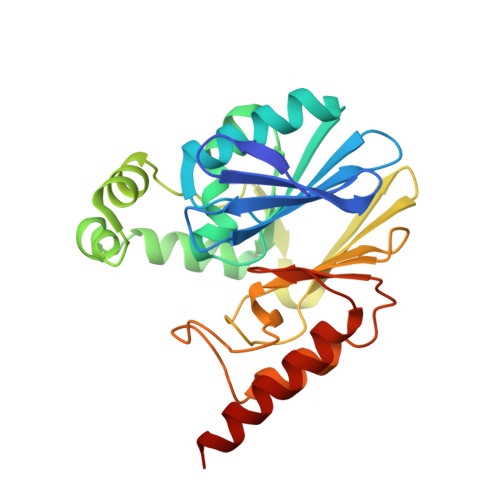Cyclobutanone Mimics of Intermediates in Metallo-beta-Lactamase Catalysis.
Abboud, M.I., Kosmopoulou, M., Krismanich, A.P., Johnson, J.W., Hinchliffe, P., Brem, J., Claridge, T.D.W., Spencer, J., Schofield, C.J., Dmitrienko, G.I.(2018) Chemistry 24: 5734-5737
- PubMed: 29250863
- DOI: https://doi.org/10.1002/chem.201705886
- Primary Citation of Related Structures:
5NDB, 5NDE - PubMed Abstract:
The most important resistance mechanism to β-lactam antibiotics involves hydrolysis by two β-lactamase categories: the nucleophilic serine and the metallo-β-lactamases (SBLs and MBLs, respectively). Cyclobutanones are hydrolytically stable β-lactam analogues with potential to inhibit both SBLs and MBLs. We describe solution and crystallographic studies on the interaction of a cyclobutanone penem analogue with the clinically important MBL SPM-1. NMR experiments using 19 F-labeled SPM-1 imply the cyclobutanone binds to SPM-1 with micromolar affinity. A crystal structure of the SPM-1:cyclobutanone complex reveals binding of the hydrated cyclobutanone through interactions with one of the zinc ions, stabilisation of the hydrate by hydrogen bonding to zinc-bound water, and hydrophobic contacts with aromatic residues. NMR analyses using a 13 C-labeled cyclobutanone support assignment of the bound species as the hydrated ketone. The results inform on how MBLs bind substrates and stabilize tetrahedral intermediates. They support further investigations on the use of transition-state and/or intermediate analogues as inhibitors of all β-lactamase classes.
- Department of Chemistry, University of Oxford, 12 Mansfield Road, Oxford, OX1 3TA, UK.
Organizational Affiliation:




















